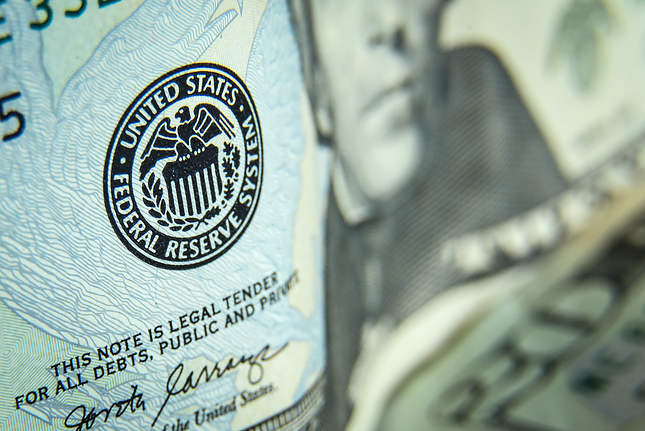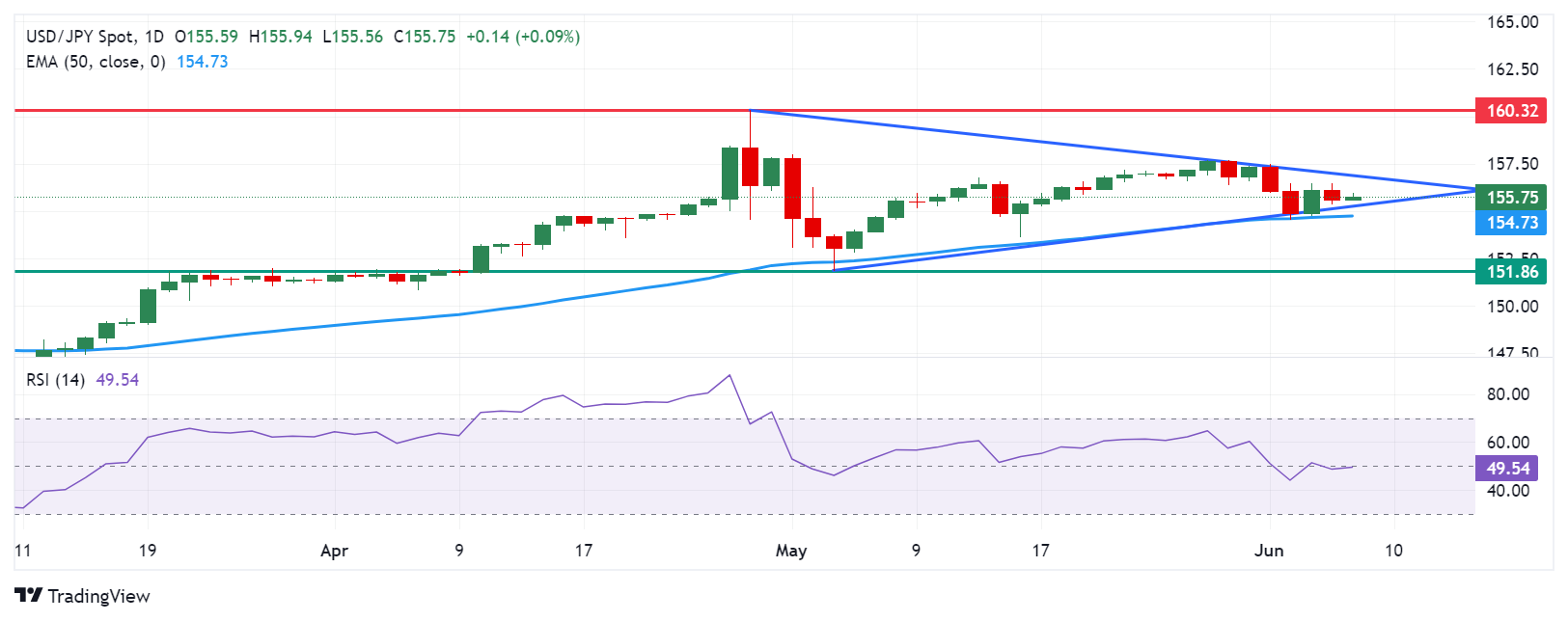- The Japanese Yen moves sideways as investors turn cautious ahead of the US NFP.
- Japan’s Foreign-exchange reserves fell to $1,231 billion in May, marking the lowest level since February 2023.
- The US Dollar struggles due to rising hopes for two interest rate cuts by the Fed in 2024.
The Japanese Yen (JPY) consolidates on Friday following the Japanese Foreign Reserves released by the Ministry of Finance for May, dropping significantly to $1,231 billion in May from $1,279 billion. This has marked the lowest level since February 2023, as the government conducted foreign exchange intervention operations to defend the JPY.
Japanese Finance Minister Shunichi Suzuki stated on Friday that he will take action against excessive currency volatility when necessary and will assess the effectiveness of intervention. Suzuki emphasized the importance of maintaining market trust in public finances, mentioning that there is no fund limit for FX intervention, according to Reuters.
The US Dollar (USD) struggled as the lower employment data from the United States (US) fueled hopes for two interest rate cuts by the US Federal Reserve (Fed) in 2024. A Reuters poll from May 31 to June 5 indicated that nearly two-thirds of economists now predict an interest rate cut in September. Additionally, the CME FedWatch Tool suggests the probability of a Fed rate cut in September by at least 25 basis points has increased to nearly 70.0%, up from 51.0% a week earlier.
Daily Digest Market Movers: Japanese Yen stays steady ahead of US labor data
- Japanese bond yields have pulled back from recent highs, with the benchmark 10-year government bond yield falling below 1% for the first time in two weeks.
- On Thursday, Initial Jobless Claims showed the number of people claiming unemployment benefits in the US increased by 8,000 to 229,000 for the week ending May 31, surpassing market expectations of 220,000.
- According to Reuters, while speaking to parliament on Thursday, Bank of Japan (BoJ) Governor Kazuo Ueda stated that inflation expectations are gradually rising but have yet to reach 2%. Ueda said, "We are still scrutinizing market developments since the March decision. As we proceed in exiting our massive monetary stimulus, it's appropriate to reduce bond purchases." Additionally, the Bank of Japan (BoJ) board member Toyoaki Nakamura remarked that, according to current data, it is suitable to maintain the policy intact for the time being.
- The ISM US Services PMI on Wednesday soared to 53.8 in May, marking its highest level in nine months and significantly surpassing the forecast of 50.8. In contrast, the ADP US Employment Change report showed that 152,000 new workers were added to payrolls in May, the lowest in four months and well below the forecast of 175,000 and the downwardly revised figure of 188,000 for April.
- The Jibun Bank Japan Services PMI was revised higher to 53.8 in May from the previous figure of 53.6. Despite the upward revision, it fell short of April's 8-month peak of 54.3, indicating the softest growth in the service sector since February.
Technical Analysis: USD/JPY hovers around 155.50
USD/JPY traded around 155.80 on Friday. The daily chart suggests a sideways trend as the pair consolidates within a symmetrical triangle pattern. Additionally, the 14-day Relative Strength Index (RSI) is slightly below the 50 level, indicating a lean toward the downside.
Immediate support for the USD/JPY pair could be found at the psychological level of 155.00. Further support appears at the 50-day Exponential Moving Average (EMA) of 154.73. A break below this level could increase pressure on the pair, potentially leading it toward the throwback support region around 151.86.
On the upside, a key barrier is evident at the upper threshold of the symmetrical triangle at 156.80. If the USD/JPY pair breaks above this level, it would weaken the bearish bias and could lead the pair to test the psychological barrier of 157.00, followed by the level of 160.32, its highest level in over thirty years.
USD/JPY: Daily Chart
Japanese Yen price today
The table below shows the percentage change of the Japanese Yen (JPY) against listed major currencies today. Japanese Yen was the strongest against the New Zealand Dollar.
| USD | EUR | GBP | CAD | AUD | JPY | NZD | CHF | |
| USD | 0.02% | -0.01% | 0.06% | 0.01% | -0.11% | 0.10% | 0.03% | |
| EUR | -0.02% | -0.02% | 0.05% | 0.00% | -0.12% | 0.08% | 0.02% | |
| GBP | 0.01% | 0.02% | 0.09% | 0.02% | -0.08% | 0.12% | 0.04% | |
| CAD | -0.06% | -0.05% | -0.07% | -0.05% | -0.16% | 0.03% | -0.05% | |
| AUD | -0.02% | 0.00% | -0.04% | 0.04% | -0.12% | 0.08% | 0.02% | |
| JPY | 0.12% | 0.08% | 0.06% | 0.15% | 0.11% | 0.19% | 0.12% | |
| NZD | -0.11% | -0.08% | -0.11% | -0.04% | -0.08% | -0.21% | -0.07% | |
| CHF | -0.02% | -0.02% | -0.04% | 0.03% | 0.00% | -0.13% | 0.07% |
The heat map shows percentage changes of major currencies against each other. The base currency is picked from the left column, while the quote currency is picked from the top row. For example, if you pick the Euro from the left column and move along the horizontal line to the Japanese Yen, the percentage change displayed in the box will represent EUR (base)/JPY (quote).
Japanese Yen FAQs
The Japanese Yen (JPY) is one of the world’s most traded currencies. Its value is broadly determined by the performance of the Japanese economy, but more specifically by the Bank of Japan’s policy, the differential between Japanese and US bond yields, or risk sentiment among traders, among other factors.
One of the Bank of Japan’s mandates is currency control, so its moves are key for the Yen. The BoJ has directly intervened in currency markets sometimes, generally to lower the value of the Yen, although it refrains from doing it often due to political concerns of its main trading partners. The current BoJ ultra-loose monetary policy, based on massive stimulus to the economy, has caused the Yen to depreciate against its main currency peers. This process has exacerbated more recently due to an increasing policy divergence between the Bank of Japan and other main central banks, which have opted to increase interest rates sharply to fight decades-high levels of inflation.
The BoJ’s stance of sticking to ultra-loose monetary policy has led to a widening policy divergence with other central banks, particularly with the US Federal Reserve. This supports a widening of the differential between the 10-year US and Japanese bonds, which favors the US Dollar against the Japanese Yen.
The Japanese Yen is often seen as a safe-haven investment. This means that in times of market stress, investors are more likely to put their money in the Japanese currency due to its supposed reliability and stability. Turbulent times are likely to strengthen the Yen’s value against other currencies seen as more risky to invest in.
Information on these pages contains forward-looking statements that involve risks and uncertainties. Markets and instruments profiled on this page are for informational purposes only and should not in any way come across as a recommendation to buy or sell in these assets. You should do your own thorough research before making any investment decisions. FXStreet does not in any way guarantee that this information is free from mistakes, errors, or material misstatements. It also does not guarantee that this information is of a timely nature. Investing in Open Markets involves a great deal of risk, including the loss of all or a portion of your investment, as well as emotional distress. All risks, losses and costs associated with investing, including total loss of principal, are your responsibility. The views and opinions expressed in this article are those of the authors and do not necessarily reflect the official policy or position of FXStreet nor its advertisers. The author will not be held responsible for information that is found at the end of links posted on this page.
If not otherwise explicitly mentioned in the body of the article, at the time of writing, the author has no position in any stock mentioned in this article and no business relationship with any company mentioned. The author has not received compensation for writing this article, other than from FXStreet.
FXStreet and the author do not provide personalized recommendations. The author makes no representations as to the accuracy, completeness, or suitability of this information. FXStreet and the author will not be liable for any errors, omissions or any losses, injuries or damages arising from this information and its display or use. Errors and omissions excepted.
The author and FXStreet are not registered investment advisors and nothing in this article is intended to be investment advice.
Recommended content
Editors’ Picks

AUD/USD holds steady near 0.6250 ahead of RBA Minutes
The AUD/USD pair trades on a flat note around 0.6250 during the early Asian session on Monday. Traders brace for the Reserve Bank of Australia Minutes released on Tuesday for some insight into the interest rate outlook.

USD/JPY consolidates around 156.50 area; bullish bias remains
USD/JPY holds steady around the mid-156.00s at the start of a new week and for now, seems to have stalled a modest pullback from the 158.00 neighborhood, or over a five-month top touched on Friday. Doubts over when the BoJ could hike rates again and a positive risk tone undermine the safe-haven JPY.

Gold price bulls seem non-committed around $2,620 amid mixed cues
Gold price struggles to capitalize on last week's goodish bounce from a one-month low and oscillates in a range during the Asian session on Monday. Geopolitical risks and trade war fears support the safe-haven XAU/USD. Meanwhile, the Fed's hawkish shift acts as a tailwind for the elevated US bond yields and a bullish USD, capping the non-yielding yellow metal.

Week ahead: No festive cheer for the markets after hawkish Fed
US and Japanese data in focus as markets wind down for Christmas. Gold and stocks bruised by Fed, but can the US dollar extend its gains? Risk of volatility amid thin trading and Treasury auctions.

Bank of England stays on hold, but a dovish front is building
Bank of England rates were maintained at 4.75% today, in line with expectations. However, the 6-3 vote split sent a moderately dovish signal to markets, prompting some dovish repricing and a weaker pound. We remain more dovish than market pricing for 2025.

Best Forex Brokers with Low Spreads
VERIFIED Low spreads are crucial for reducing trading costs. Explore top Forex brokers offering competitive spreads and high leverage. Compare options for EUR/USD, GBP/USD, USD/JPY, and Gold.
